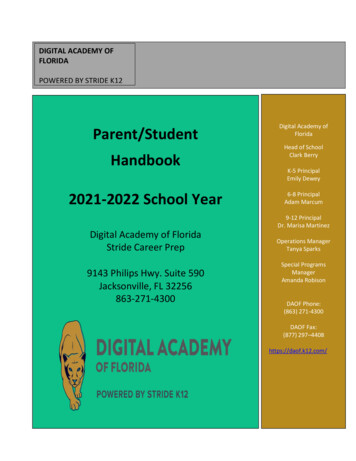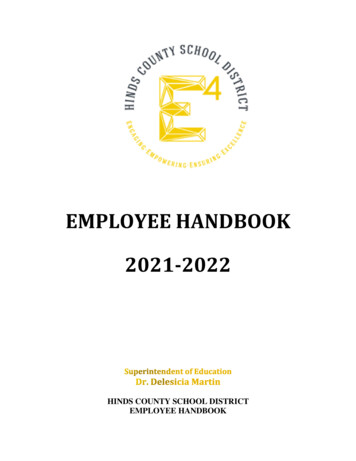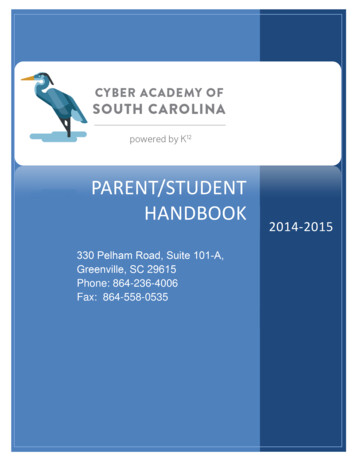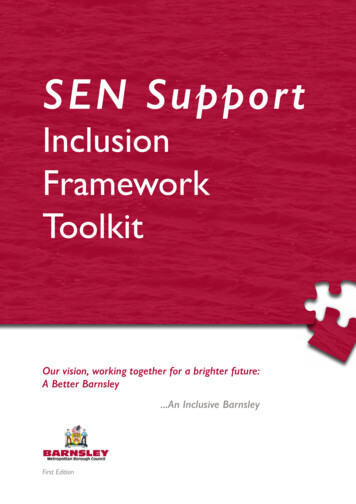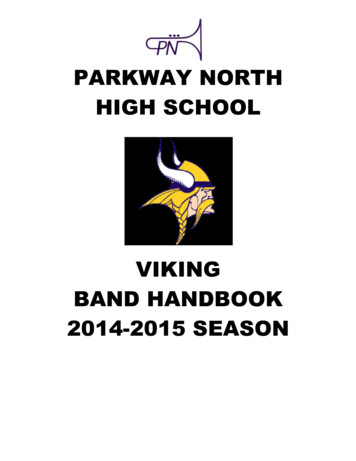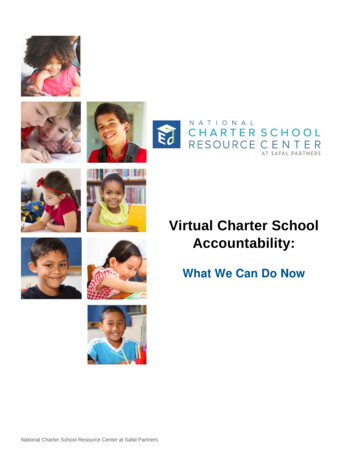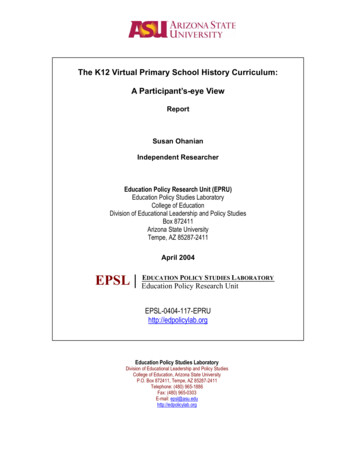
Transcription
The K12 Virtual Primary School History Curriculum:A Participant’s-eye ViewReportSusan OhanianIndependent ResearcherEducation Policy Research Unit (EPRU)Education Policy Studies LaboratoryCollege of EducationDivision of Educational Leadership and Policy StudiesBox 872411Arizona State UniversityTempe, AZ 85287-2411April 2004EPSL EDUCATION POLICY STUDIES LABORATORYEducation Policy Research ion Policy Studies LaboratoryDivision of Educational Leadership and Policy StudiesCollege of Education, Arizona State UniversityP.O. Box 872411, Tempe, AZ 85287-2411Telephone: (480) 965-1886Fax: (480) 965-0303E-mail: epsl@asu.eduhttp://edpolicylab.org
The K-12 Virtual Primary School History Curriculum:A Participant’s-eye ViewSusan OhanianIntroductionImagine a first grade classroom: Anywhere, USA, circa 2004. The teacher hasexplained that ancient Egyptians believed that amulets would fight off evil spirits, and sothese amulets or charms were tucked inside the wrapping of the embalmed body toprotect the mummy in the next life. The teacher tells the first graders that one type ofamulet, a certain beetle called a scarab, represented a person’s soul and was a symbol oflife after death in ancient Egypt. She tells them about some other charms: that the eyewas the symbol of protection and that the lotus flower kept evil spirits away. The teacherthen gives the 6-year-old students a coloring sheet with these different symbols, and sheinvites them to make their own scarabs out of clay—to create objects to keep themselvessafe from danger.1Plenty of adults would be very disturbed by this type of a lesson; after all, theAmerican Library Association’s (ALA) Office for Intellectual Freedom reports that theHarry Potter series has topped the list of books most challenged for the past four years—because they depict wizardry and magic.Yet the above lesson was not from a progressive classroom but from a “back-tobasics curriculum” marketed to home-schooling families by K12 Inc., a company headedby former US Education Secretary William J. Bennett. There is an irony here: whilefamilies who choose to home school their children do so out of diverse motives, a
significant percentage are driven by the desire to inject a more openly religious andvalues-based education into the curriculum. Bennett himself has, since leaving office in1992, championed a return to “virtue” and “values” in the education of Americanchildren. To the extent that religiously conservative homeschoolers choose Bennett’sK12 curriculum (and no data are available to show the ideological makeup of thecurriculum’s users), however, this group would appear to be disregarding the fact that itintroduces the occult, superstition, and magic. That is the least of the curriculum’sproblems, however. As we will see, it includes much sex and gore.The lack of moral compass is a curious phenomenon. As the Washington Monthlynoted, for more than 20 years, as a writer, speaker, government official, and politicaloperative, William J. Bennett, who heads K12 and directs the curriculum, “has been acommanding general in the culture wars,” making a cottage industry of merchandise tieins and a PBS cartoon series out of bully pulpit on virtue. 2 Besides his grants fromconservative foundations, Bennett collects 50,000 per appearance on the lecture circuit.In “Seizing This Teachable Moment,”3 posted on the Thomas B. FordhamFoundation Website as part of a response to September 11, 2001, Bennett writes,“children ought to learn about right and wrong. For too long, so-called sophisticates havesaid that right and wrong are matters of opinion, of personal preference, of one’s owntaste.” Bennett goes on to denounce the “intellectually dishonest” who argue “that thereis no such thing as evil.” 4Yet the K12 curriculum, relentless in its presentation of map skills, warriors, andthe hierarchy of the Catholic Church, rarely provides a moral message about some of theappalling historical events it includes. Kindergartners get Andrew Carnegie as an ethicalPage 2 of 33
model; first and second graders get warriors. Second graders are instructed to traceHannibal’s route on a map rather than consider the implications of his use of elephants.First graders get the Trojan War, with the objectives of the lesson being: Find Greece onthe map of ancient Greece. Find Troy. Identify Priam as the King of Troy. IdentifyOdysseus as a Greek hero. That’s it. Greek and Roman myths provide the “story” in“history”: tales of incest, rape, and murder. No moral comment is provided, other than toremind children that this is fiction, not fact. Throughout the curriculum, history isstripped of moral import and objectified as discrete facts to be memorized.BackgroundGo to K12.com and you will read:William J. Bennett, along with other leaders who are passionate about education,founded K12 in 1999. The goal was to create an excellent, traditional program ineducation—one that would empower parents to be effective teachers andempower students to explore the world around them thoughtfully. 5The Website informs parents that K12 “provides everything you need to give your childan excellent education at home, from lessons and materials to planning tools andassessments.”6Bennett has written skeptically of technology’s educational value. In TheEducated Child, published in 2000, he asserted: “When you hear the next pitch aboutcyber-enriching your child’s education, keep one thing in mind: so far, there is no goodevidence that most uses of computers significantly improve learning.”7 Bennett’s owncritique, however, didn’t discourage him from launching K12 Inc. with 10 million inPage 3 of 33
seed money from Knowledge Universe, Inc., the education conglomerate based in MenloPark, California, and owned by former junk-bond king and convicted felon MichaelMilken.8William BennettIn examining K12, one must start with William Bennett. Bennett is aDistinguished Fellow at The Heritage Foundation, supported by grants from the OlinFoundation.9 On the Empower America Website, Bennett is characterized as “one of ournation’s most informed, well-respected, and tenacious advocates of bold educationreform. . . .” 10Bennett is the author or editor of: The Book of Virtues for Young People: ATreasury of Great Moral Stories, The Children’s Book of Heroes, Our Sacred Honor:Words of Advice from the Founders in Stories, Letters, Poems, and Speeches, TheChildren’s Book of Faith, The Children’s Book of America, Our Country’s Founders: ABook of Advice for Young People, and The Children’s Book of Home and Family. As theWall Street Journal noted, “Give him 10 old books and behold, he returns with five newones.” Richard Cohen of the Washington Post called William Bennett “The MarthaStewart of Morality.”K12: The Media Gives a Pass on the Unexamined CurriculumIn August 2001, Eleanor Chute, Pittsburgh Post-Gazette Education Writer,credited Bennett with taking “a hands-on role in the program.”11 Bennett told thenewspaper: “I am now convinced with the program we developed we are usingtechnology in the right way.” Bennett insisted that “students in the early grades willPage 4 of 33
spend 75 to 80 percent of the time off-line, with books and hands-on activities. Lessonswill be adapted to the needs of each student.”No mention is made of how much time Mom must spend online to print out all thematerial. Furthermore, the claim that lessons are adapted to the needs of each student isnot borne out by the facts. If a student misses more than 20 percent of a lessonassessment, the parent is told the student must repeat the lesson. If the student againmisses more than 20 percent, the instruction is to repeat the lesson again. And again.The so-called “needs of each student” is an endless loop of repetition of the samematerial. There are no suggestions as to what a parent might do if children don’tunderstand a concept; instead, a Teacher Tips section presents quirky bits of arcaneadditional information—such as the meat curing practices of the Huns.Writing in Education Week,12 Michelle Galley notes that a student enrolled in anonline school managed by K12 receives, according to Bror Saxberg, the senior vicepresident for learning and content for K12, “a computer, a printer, and four to sixboxes—or 90 pounds—of materials, including workbooks, textbooks, and‘manipulatives’ to study language arts, mathematics, science, history, art, and music.”Despite the emphasis on quantity, it appears no reporter has examined the quality of thegoods. While public schools are rated by standards and assessments, K12 is rated by theweight of goods received.The Home-schooling DisconnectionA casual spectator is likely to assume that K12’s obvious sales targets are theparents of the 1.5 to 2 million homeschoolers; in the spring of 2003, K12 did make a bigpush to target this group in certain states as potential users. Homeschoolers in Ohio, forPage 5 of 33
example, were bombarded with slick mailings announcing an April K12 Innovation inEducation Expo in Columbus. Nonetheless, all evidence suggests that homeschoolers arefar from the primary customers K12 seeks. Rather, the company is after public money:K12 is not a school; it is a company that provides a research-based curriculum,innovative instructional tools, and top-quality school management services toschools across America. K12 also serves home-schooling families by making aportion of its curriculum available for direct purchase by consumers.13K12 is mainly interested in offering management services to schools; homeschooling families interested in the curriculum but not willing to sign up with theseschools appear to be of secondary interest. After I purchased K12 curriculum materials,messages from K12 told me that, as an individual subscriber, I was part of the K12Online School (OLS). Indeed, speaking in August 2003 to the St. Petersburg Times,Bennett said of K12: “This isn’t home schooling Florida Virtual Academy is a publicschool.” 14 K12 receives 4,800 for each student from Florida taxpayers. Students arerequired to log 900 hours of academic work. To receive reimbursement from the state,K12 must demonstrate that the children enrolled showed one year’s academic growth:Students will be expected to take the Florida Comprehensive Assessment Test (FCAT) atthe end of the year.In seeking public reimbursement, K12 has in fact alienated itself from somehomeschoolers, with some home-schooling associations waving warning flags aboutgetting involved with the company. The Ohio Home Education Coalition (OHEC), forone, is concerned about the way K12 links home schooling with the company’s publiclyPage 6 of 33
funded charter schools.15Bennett denies any such linkage,16 but as OHEC observes, thefirst sentence in the pamphlet for K12’s publicly funded Ohio virtual charter school isthat attendees to the Education Expo will “Meet other Ohio Virtual Academy (OHVA)families, staff, interested parents, and K12 home-schooling families.” In short, theskeptics suggest, homeschoolers who join a Virtual Academy should be advised that oncethey accept their 90 pounds of goods from K12, they and their children will be under thethumb of the state. As the Wisconsin Parents Association (WPA), a support organizationfor homeschoolers in the state, points out, people who enroll in public e-schools must: “Keep extensive records and report on the hours of study each day foreach child. Comply with state standards in education. Take state-mandated tests, which determine their curriculum,since students have to study what will be on the tests. Work individually with each child, since subject matter is different foreach grade.17The WPA has taken a position that so-called virtual charter schools should insteadbe labeled “public e-schools” and has issued a report charging that Bennett’s involvementwith them “undermines home schooling.”18K12-linked Virtual Academies in other states actively define themselves as publicschools and acknowledge they are operating under regulations applying to public schools.The Ohio Virtual Academy Website, for example, includes a legal notice:The Ohio Virtual Academy is a community school established under Chapter3314 of the Revised Code. The school is a public school and students enrolled inPage 7 of 33
and attending the school are required to take proficiency tests and otherexaminations prescribed by law. In addition, there may be other requirements forstudents at the school that are prescribed by law. Students who have beenexcused from the compulsory attendance law for the purpose of home educationas defined by the Administrative Code shall no longer be excused for that purposeupon their enrollment in a community school. 19Most parents who choose to teach their children at home do so in order to avoidthis very kind of bureaucracy and government intrusion into their lives.Getting Started with the K12 CurriculumThe acknowledgments page of K12’s history curriculum indicates that “Portionsof K12’s history program for Grades 1 and 2 were written by Susan Wise Bauer.” Baueris the Creative Director of Peace Hill Press, which publishes her series The Story of theWorld, Vol 1 and 2. In 2003, W. W. Norton published Bauer’s The Well-Educated Mind:A Guide to the Classical Education You Never Had.Apparently, Bauer doesn’t always use her own curriculum. In a diary entry titledHome School Day, she gives a breathless account of her day with her four children, ages9, 7, 4, and infant. The narrative is amusing, with whiny kids and chocolate smears. Thehistory lesson reveals plenty:11:30 [The baby] is happy, so I put everyone on the sofa and start history. Todaywe’re working on our Presidents Memorization Project—we color pictures of twopresidents from the Bellerophon coloring book, Christopher looks them up in theencyclopedia and writes down two interesting facts about each president, and wePage 8 of 33
all chant the presidents in order. We’re up to Andrew Jackson and Martin VanBuren. I tell Christopher and Ben to STOP TALKING UNTIL THEIRPICTURES ARE COLORED. 20Bauer mentions later that her husband is reading Jean Fritz’s Can’t You MakeThem Behave, King George with the children. I want to call up Bauer and ask, “Hey,where does this Presidents Memorization Project fit in with the K12 history curriculum?”Answer: it doesn’t. K12 Students get Shamshi-Adad, Lei Zu, Amenhotep, and theLibrary of Nineveh, for starters. Her own kids get Jean Fritz and we get the Code ofHammurabi.The reliance on coloring books, though, carries over to the K12 curriculum. Thehapless K12 parent waits for an activity to download in a PDF file—only to find yetanother quite dreadful coloring book page to print out. These pages are dull, lifeless, andpedantic. They detract from the lessons.Technology OverviewAlthough one of K12’s selling points is its use of technology, a huge technologyproblem is that periodically the user cannot get into the K12 site. On May 23, 2003, K12explained it thusly:The K12 Online School (OLS) relies on a number of free software packages, or“plugins,” to display information to our home-schooling families. Since mostonline computer applications are constantly being upgraded, users sometimesdiscover that they are unable to view certain files. This is usually due to the factthat they have not updated their computers with the latest version of the software.Page 9 of 33
This was the first I heard that I was part of a school. In desperation, I phonedK12—and was told that to enter their site I had to remove all cookies from my computer(a major annoyance to anyone who regularly orders books from Amazon.com or visits theNew York Times). And the people giving advice at K12 insist that it is my computerthat’s causing the problem, not their system. (They must receive many such complaints,judging from the fact that they have form letters to respond to them.) In August 2003, Icomplained about not being able to log on—to which the automatic reply was:There is a dangerous computer virus traveling over the Internet that is impactingmany homes and businesses throughout the world, including some of you, ourK12 PC users. . . . If you are unable to log onto our K12 Online School, that maybe a symptom that your PC is already infected with this virus. . . .In early November, 2003, the K12 site was down for a few days with what weretermed “systems issues.” The “issues” included losing student work. KU kept sendingout messages asking parents to be patient. Then came this message:From: “OLS-Errors” ols errors@k12.com To: “OLS-Down-110603-2” ols errors@k12.com ; “OLS-Down-110603-2” ols errors@k12.com ; “OLS-Down-110603-2” ols errors@k12.com ; “OLSDown-110603-2” ols errors@k12.com ; “OLS-Down-110603-2”This went on and on—filling three pages. Another glitch: K12 Virtual Academies arenamed in the Fujitsu Class Action suit for failure of hard drives on the computers theylend participants in the Virtual Academies.21Page 10 of 33
Of greater technological concern is K12’s failure to use computers for anythingother than a delivery system of workbook-style pages resembling the old filmstrips fromthe 1950s. The graphic presentations couldn’t be duller or uglier.The pictures resemble static old filmstrips, and the program is cheap about the useof even these paltry illustrations. Typically, a "reading room" presentation repeats onepicture on three screens—no matter what is going on in the text. A case in point is in thestory of Cincinnatus (a Roman farmer briefly appointed dictator about 450 years beforethe birth of Jesus). The text tells readers that Cincinnatus was a poor working man; thepicture shows him behind two oxen pulling a plow. On the next screen the picture isrepeated, although the text is about fierce men plundering the countryside. Page 3 repeatsthe same image of Cincinnatus and the oxen, yet the text tells us: "But one morning, fiveRoman horsemen came riding down the road from the mountains. They rode with greatspeed, and both men and horses were covered with dust and blood. The guard at the gateshouted to them as they galloped in: 'Why are you riding like this? What has happened tothe Roman army?'"The picture finally changes on screen 4. Cincinnatus is moving away from theplow and someone is bringing him a robe. Soldiers are rushing up to him. But the text isall about the soldiers' experience near Rome; Cincinnatus isn't mentioned. Screen 5shows the same picture, while the text tells of soldiers telling their tale to senators, whoare worried. Someone says, "Send for Cincinnatus.” The picture finally becomesrelevant to the text with the last sentence on the page, when we learn that Cincinnatuswas in the field plowing when his aid was sought. Screen 6 repeats the picture, and herewe finally learn that it is his wife bringing him a cloak.Page 11 of 33
Screen 7 shows Cincinnatus sitting on his horse (oddly, the cloak is not in sight),with soldiers on horseback following. Screen 8 repeats the same image, yet the textreports he saved Rome and then returned home to plow.One might reasonably suppose that someone seeking to hold the interest ofchildren so young would at least strive to illustrate many more of the story developmentpoints, and choose more dynamic images.On the rare occasions when K12 does recommend that a student view Internetsites, the results can be bizarre. Here’s a sample from the kindergarten Language Artscurriculum. While reading the story “Lion at School,” the student is directed to the LionResearch Center (http://www.lionresearch.org/main.html). Visit the site and you can reada study on lion manes that examines the question of whether longer or darker manesattract female lions. The material, however, is clearly written for a scientifically literate,adult audience—people for whom Scientific American is bedtime reading—not primaryage children and their parents. There are, however, features at the site arguably moreaccessible to the curriculum’s target audience, such as the recorded sound of a lionroaring. The K12 directions give no hint of this, and it’s doubtful that many parents and5-year-olds will plow through the research to find the roar.History Curriculum for Grades K, 1, and 2The K12 history curriculum is a pumped-up version of the curriculum E. D.Hirsch, Jr. outlined in his What Your Grader Needs to Know series. The series is basedon the premise that children can and should be taught the origins of classical WesternCulture starting in the earliest years in school. Hirsch’s critics contend that his proposalsstand in stubborn opposition to what is known as developmentally appropriate practicePage 12 of 33
(DAP) —the philosophy that children learn more effectively in environments that allowthem to work independently and with each other to construct their own knowledge, ratherthan in settings in which teachers “strictly define what students need to learn and howthey will learn it.”22 Despite research supporting DAP,23 Hirsch regards it with disdain.24And so, we get the Code of Hammurabi for first graders:An eye for an eye, and a tooth for a tooth. If a man puts out the eye of anotherman, put his own eye out. If he knocks out another man’s tooth, knock out hisown tooth. If he breaks another man’s bone, break his own bone.These concrete images may give first graders nightmares.In her denunciation of developmentally appropriate curriculum, Diane Ravitchlamented the absence of mythology, legends, biographies, hero tales, and stories from thesocial studies curriculum.25 K12 fills this perceived gap, delivering myths filled withincest and infanticide, endless accounts of wars, biographies of Attila the Hun andGenghis Khan, and the story of Caesar being killed by 23 of his friends. (In the Hirschversion, it was 23 enemies, but K12 insists they were friends.)K12 History for Kindergartners: An OverviewThe entire first half of the kindergarten course is geography. Right off, the lessonobjective is to “recognize a globe as a model of the Earth and a world map as a flat modelof the globe.” The small inflatable globe that is shipped out from K12 is woefullyinadequate for such an enterprise; but, the real question is: What have you got whenyou’ve got a 5-year-old who can recite that a globe is a model of the earth? K12 ignoressuch issues, which have to do with the nature of childhood, cognitive development, andPage 13 of 33
the purpose of schooling; instead, the curriculum relentlessly pushes ahead with elicitingmemorized replies to adult questions.Objective: Recognize a globe as a model of the Earth.Assessment: What is a globe?Answer required for mastery: A globe is a model of the Earth.Here’s a typical K12 lesson activity. In the “Continent Echo Song,” the adultnames a continent, and the child repeats it:Adult: North AmericaChild: North AmericaAdult: South AmericaChild: South AmericaAdult: AntarcticaChild: AntarcticaAnd so on. “Show Joe how to find the North Pole and the South Pole. Have himput his finger on each and say its name.” This is a have-your-dog-heel approach toprimary education.While studying China, Joe is invited to find the year of his birth and his animalsign on the zodiac: Discuss Joe’s animal sign. Talk about the positive attributes of thePage 14 of 33
animal. The directions indicate: “Don’t take the zodiac signs too seriously—just havefun!” Yet the lesson seems dubious on various grounds. For starters, how does a 5 year-old feel about having the rat as his sign? Just what are the positive attributes of therat? The snake? The boar? Does anyone at K12 care about the misery of the little kidwho finds out he was born in the year of the rat? Or the snake?Hirsch and K12 both admit that the story of George Washington and the cherrytree is a legend, and both suggest it nonetheless provides a moral lesson, but K12’saccount is filled with colorful detail. The lesson here is that history can be distorted—and lied about—if it suits a moral-political agenda.I complain incessantly about the tiny pictures Joe is asked to color. Finally, withEleanor Roosevelt, we get a big picture: two bare feet covering the entire page. Joe istold that people often said Eleanor left behind golden footprints. As Joe’s teacher, I amsupposed to help him figure out what this means. Then he can glue gold glitter onto thebig bare feet on the page. Kindergartners may well find the glitter fun, but I wonderabout the metaphor: will they remember Eleanor as a committed leader, or as a womanwith huge feet?26TechnologyOn occasion, rare occasion, a computer resource is mentioned in a lesson—a URLthat takes the student out of K12 and into the World Wide Web. For example, for thelesson on directions and compass rose study, the U.S. Naval Observatory site CompleteSun and Moon Data for One Day is recommended.27 I’ve never known a kindergartnerwho’d want to know about “times of sunrise, sunset, moonrise, moonset, transits of theSun and Moon, and the beginning and end of civil twilight, along with information on thePage 15 of 33
Moon’s phase.” Not knowing the term “civil twilight,” I went in search of its meaning:The period of twilight beginning (or ending) when the center of the (refracted) Sun ismore than 6 below the horizon (as distinguished from Astronomical Twilight, NauticalTwilight, and Twilight).Call me chicken, but I decided to pass on sharing this information with Joe.The Internet recommendation for the unit on Junipero Serra (a Spanish Franciscanwho founded California’s first Catholic missions) is California Mission History, whereone can visit the gift shop and buy a recording of A Choir of Angels II: Mission Music byZephyr .html).Here’s some sample text from the Website: “Between the two dates [1493 and1769], there is an interval of almost 300 years during which the mission system grew tobe a philosophy of human rights, put forward and defended by the religious orders, andbitterly opposed by the secular elements among the colonists.” 28K12 First Grade HistoryThe first three lessons in the K12 history curriculum review geographic contentfrom the kindergarten curriculum: name the continents and major oceans, reviewdirections on a map, and so on. Then begins a rather mind-boggling curriculum for a 6 year-old: History from the Stone Age to Alexander the Great (Mesopotamia, Egypt,Greece, China, India).TechnologyIf technology was ill-used in the kindergarten unit, it’s barely used at all in firstgrade; the first grader is supposed to get all necessary information from the stagnantPage 16 of 33
words and pictures on the K12 site. In one of its very few Internet offerings, the lessonintroducing Canaan and Ancient Israel recommends the University of PennsylvaniaMuseum of Archaeology and Anthropology site, which includes activities for children 8to 12 (http://www.museum.upenn.edu/new/edu/kids/kids main.shtml).Getting StartedFor parents who may not feel confident to teach a curriculum that extends fromthe Stone Age in 5000 B.C. to ancient India in 200 B.C., including the Egyptians, theIsraelites, Mesopotamia, ancient Greece, India, and China, K12 says: “Don’t worry. TheK12 program does not assume that you have extensive preparation in either world orAmerican history. Rather, lessons are designed to provide background knowledge as youproceed.” K12 provides a script to make this happen: Have Mary Beth locate the Fertile Crescent on the map you printed(from a PDF file). Ask Mary Beth to point to the Mediterranean (med-ih-terr-AY-neean) Sea, the Caspian Sea, the Black Sea, and the Red Sea. Have Mary Beth practice saying the names aloud with you. Identify the Nile River. Tell Mary Beth that the Nile River flowsinto the Mediterranean Sea.After more of this type of adult-directed lesson with parroted student answers,Mary Beth takes an assessment: Did Mary Beth find the Nile River on the map? Did Mary Beth locate the Egyptian Empire along the Nile?Page 17 of 33
Did Mary Beth answer the question: What does the flooding of theNile leave behind?If Mary Beth misses one question, the parent receives this message: The lessonshould be redone to ensure mastery of this lesson’s objectives. If she repeats theassessment and still misses one, the instructions are to repeat again—to ensure mastery.In a classroom, an experienced teacher will give children who didn’t understand thematerial alternatives—giving children a variety of activities that would come at thematerial from other modes of learning, so they might better comprehend the conceptscovered in the materials. Such strategies would reflect multiple intelligence theorypioneered by Howard Gardner.29 With K12, if one insists on mastery, the only option isto repeat the same lesson again and again.The Story in History: Infanticide and the Killing FieldsIn its promotional material, K12 emphasizes that it is putting the “story” back in“history.” And what story do they tell? Isis and Osiris. Call me conservative, but I’mnot going to read my 6-year-old a story about a guy tricked into trying out a coffin forsize, being thrown into the river, and drowning. I don’t care if he does come back to life;the story is too scary for first graders. The K12 story writer explains, “And that’s whythe Nile overflows every year—because it remembers that Osiris came back to life fromthe dead.” Most 6-year-olds won’t get this grand symbolism or the idea that this is mythrather than natural history; what they’ll get is that a guy climbed into a coffin anddrowned. Such developmentally inappropriate subject matter is characteristic of the K12history curricula. In their relentless devotion and determination to present historyPage 18 of 33
chronologically, the authors of the curricula ignore the student’s level of understanding.Chronology trumps common sense.Because this is history as chronology, Mary Beth learns that Sargon, a trustedservant to the king of Mesopotamia, sche
Online School (OLS). Indeed, speaking in August 2003 to the St. Petersburg Times, Bennett said of K12: "This isn't home schooling Florida Virtual Academy is a public school." 14 K12 receives 4,800 for each student from Florida taxpayers. Students are required to log 900 hours of academic work. To receive reimbursement from the state,


